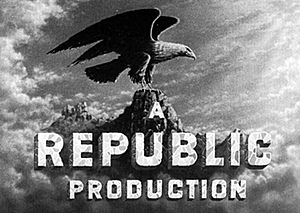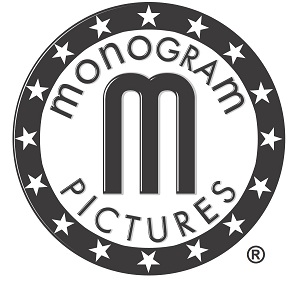Republic Pictures facts for kids
 |
|
| Motion pictures | |
| Fate | Ceased producing feature films in 1959, and later sold and absorbed by National Telefilm Associates, eventually becoming Melange Pictures, LLC |
| Predecessor | Monogram Pictures Mascot Pictures Liberty Pictures Majestic Pictures Chesterfield Pictures Invincible Pictures |
| Successor | Library: Paramount Pictures |
| Founded | 1935 |
| Founder | Herbert J. Yates |
| Defunct | 1967 |
| Headquarters | Studio City, Los Angeles, California |
Republic Pictures Corporation was an American movie company that made and distributed films from 1935 to 1967. It was based in Los Angeles, California. The company had studios in Studio City and a movie ranch in Encino.
Republic Pictures was famous for making Westerns, exciting serials (movies shown in parts), and B films. These B films were usually action-packed mysteries. Republic also helped launch the careers of famous stars like John Wayne, Gene Autry, and Roy Rogers. The company also helped fund and distribute some bigger "A" films. These included movies directed by John Ford and a Shakespeare film, Macbeth (1948), directed by Orson Welles. Under its founder, Herbert J. Yates, Republic was seen as a smaller but important film studio.
Contents
How Republic Pictures Started
Republic Pictures was created in 1935 by Herbert J. Yates. He was an investor in movies and owned a company that processed film, called Consolidated Film Industries.
During the Great Depression, bigger movie studios started doing their own film processing. This meant Yates's company wasn't as busy. Many smaller, independent movie studios were also struggling. To keep his film processing business stable, Yates decided to start his own movie studio.
He brought together six smaller studios that owed money to his film processing company. These studios were Monogram Pictures, Mascot Pictures, Liberty Pictures, Majestic Pictures, Chesterfield Pictures, and Invincible Pictures. Yates convinced them to merge under his leadership. This new company was named Republic Pictures Corporation.

- Monogram Pictures was the largest of these companies. It made "B" films and had a system to distribute movies across the country.
- Mascot Pictures Corporation was very advanced for its time. It mostly made serials and had a great studio in Studio City. Mascot also discovered Gene Autry, who became a famous singing cowboy star.
- Majestic Pictures made movies with well-known stars and used rented sets to make its films look more expensive.
- Liberty Pictures gave Republic its original "Liberty Bell" logo.
- Chesterfield Pictures and Invincible Pictures were good at making low-budget melodramas and mysteries.
By combining these companies, Republic Pictures started with experienced staff, a group of actors, a full distribution system, and a modern studio. Yates promised the original owners more freedom and bigger budgets for their films. However, Yates soon took more control. Many of the original partners left, and Yates hired new producers who were loyal to him.
Republic also bought Brunswick Records to record its singing cowboys, Gene Autry and Roy Rogers.
Making Movies
Types of Films Republic Made
In its early years, Republic was sometimes called a "Poverty Row" company. This meant it mainly made B films and serials. However, Republic often spent more money on these films than other larger studios.
The company was best known for its Westerns. Many Western stars like John Wayne, Gene Autry, Rex Allen, and Roy Rogers became famous at Republic. By the mid-1940s, Republic started making higher-quality movies with bigger budgets. Examples include The Quiet Man (1952), Sands of Iwo Jima (1949), and Johnny Guitar (1954).
Republic Pictures also avoided making movies about controversial topics. Other smaller studios sometimes made "exploitation films," but Republic stuck to safer subjects.
In 1946, Republic added animation to its Gene Autry film Sioux City Sue. This led the studio to try making animated cartoons. They made a cartoon called It's a Grand Old Nag and later a series called Jerky Journeys, but these cartoon efforts didn't last long.
From the mid-1940s, many Republic films featured Vera Hruba Ralston. She was a former ice skater from Czechoslovakia who married Herbert Yates in 1952. Yates tried to make her a big dramatic star, but audiences didn't connect with her. Even John Wayne later said he left Republic because he didn't want to make another movie with her. Still, Yates kept casting her in films until the studio stopped making movies.
Republic also made many "hillbilly" musicals and comedies. These films, featuring stars like Bob Burns and Judy Canova, were very popular in rural parts of the United States.
By the late 1940s, the movie industry faced challenges. Republic started making fewer films. They organized their movies into different types:
- "Jubilee" films were usually Westerns made quickly and cheaply.
- "Anniversary" films had slightly bigger budgets.
- "Deluxe" films were major productions.
- "Premiere" films were often made by famous directors like John Ford and had the largest budgets.
Most Republic films were in black and white. However, some higher-budget films like The Red Pony (1949) and The Quiet Man were made in Technicolor. Republic also used its own low-cost color process called Trucolor for many films. In 1956, the studio even created its own widescreen process called Naturama.
The Television Era
Republic was one of the first Hollywood studios to offer its old movies to television. In 1951, they created a special company called Hollywood Television Service to sell their old Westerns and action films for TV. Many of these movies were edited to fit into a one-hour TV slot.
Hollywood Television Service also made TV shows that looked like Republic's old serials, such as The Adventures of Fu Manchu (1956). In 1952, Republic's studio lot became the first home for MCA's TV series production company, Revue Productions.
Even though Republic seemed ready for TV production, it didn't have enough money or a clear plan. By the mid-1950s, selling old movies and renting out studio space to MCA was what kept Republic going. The studio produced Commando Cody: Sky Marshal of the Universe, which was first a serial for theaters but later sold to NBC for TV.
As TV became more popular, fewer people went to the movies. Republic started making fewer films. In 1957, they made only 18 movies, down from 40 in the early 1950s. Republic also started making films about juvenile delinquency (young people getting into trouble), like The Wayward Girl (1957).
In 1958, Herbert Yates announced that Republic would stop making feature films. The company's distribution offices closed the next year.
Republic Changes Hands
In 1958, a businessman named Victor M. Carter bought control of Republic Pictures. He changed the company into a business that included plastics and appliances, along with its film and studio rentals. The company was renamed Republic Corporations.
In 1963, Republic started leasing its studio lot to other companies, including CBS. In 1967, CBS bought the studio lot completely. Republic Pictures' role in Hollywood ended with this sale. Republic sold its library of films to National Telefilm Associates (NTA).
Today, the old Republic studio lot is known as CBS Studio Center. It is home to CBS's Los Angeles TV stations.
Republic Pictures Returns
In the early 1980s, NTA started showing many of Republic's old films on new cable television channels. This was so successful that in 1984, NTA bought the rights to the "Republic Pictures Corporation" name and logos. They renamed themselves Republic Pictures Corporation.
A new TV production part of the company was set up. It offered old episodes of TV shows like Beauty and the Beast. They also made a few new movies for theaters, such as Freeway and Bound. The company's home video division also started selling the original Republic films on video.
In 1993, this new Republic Pictures won an important legal case. They reactivated the copyright on Frank Capra's 1946 film It's a Wonderful Life. This meant they now controlled the rights to this classic movie.
In 1994, a company called Spelling Entertainment bought the Republic Pictures film library. Later that year, Spelling's parent company, Blockbuster, merged with Viacom.
In 1996, Republic stopped making new films. By the end of the 1990s, Viacom owned Republic completely, making it part of Paramount. Today, Republic Pictures is part of Melange Pictures, LLC, which is a company set up by Viacom to hold the Republic film library. The Republic name and logo are still used for re-releases of its films on DVD and Blu-ray.
|
See also
 In Spanish: Republic Pictures para niños
In Spanish: Republic Pictures para niños


